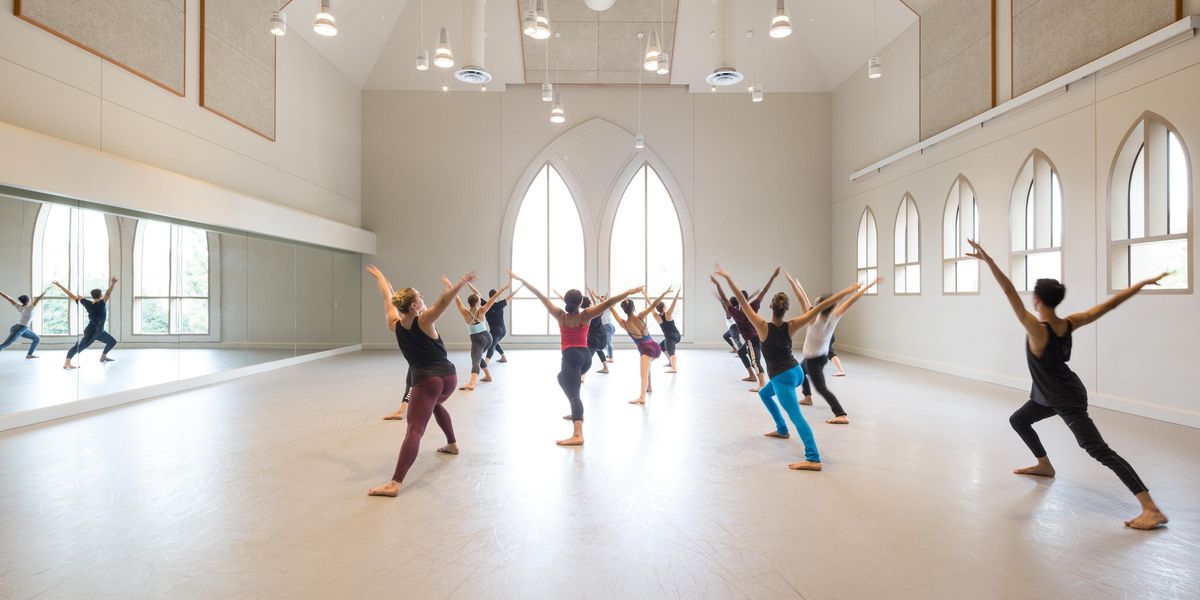Technique My Way: Julia Burrer
Open mind, healthy body
Julia Burrer (center) in Doug Varone’s
Carrugi (2012). Photo by Cylla von Tiedemann, Courtesy Doug Varone and Dancers.
Julia Burrer flows like water onstage. In Doug Varone’s Lux, her limbs slice and caress the space, her lanky 6′ 1″ frame reaching the corners of the stage even as she drops to a roll in one breathtaking movement. Burrer makes one wonder how arms could seem so supple, graceful, and powerful all at once. The 29-year-old Austin, Texas, native often talks about dancing like writing in cursive—an image which resonates after watching her fluid script of movement. Dance Magazine spoke to Burrer, a member of Doug Varone and Dancers since 2007, about warming up, eating right, and listening to your body.
Taking It One Day at a Time
With eight hours of sleep and a solid breakfast under her belt, Burrer heads to the 92nd Street Y studios for rehearsal with Varone, typically four days a week from 10 to 4. She likes to arrive at least 45 minutes early to warm up. “I check in with myself and see if I’m focused and present,” she says. While she might start with yoga, gentle improvisation, or floor work, her routine consistently includes a mix of what she describes as “adapted Pilates, physical therapy exercises, and things that I’ve learned from other teachers and changed the recipe to make my own.” She articulates her pelvis, engages her core, and uses spirals to wake up her spine. “Our rehearsals sometimes start with a full run of a piece,” she says, “so you have to get your heart rate up and get a little sweaty beforehand.”
Being Prepared
In a city filled with constant movement, Burrer has learned to think ahead about nourishment. Rehearsals don’t often leave time for a leisurely lunch, so she packs smaller, protein-filled snacks, like nuts, Greek yogurt, and fruit. Dinners fill in the food-groups that are often missed during the day, like greens and meat, and sushi is often Burrer’s go-to meal before performances. It’s light, so “you don’t feel overfull,” she says.
Learning Through Pain
Having dealt with a bulging disc in her lower back for the past few years, Burrer recognizes that with age comes wisdom. “As a younger dancer, all you want to do is dance your heart out. You put your body through crazy things. You ask a lot of it but don’t give much back,” she says. “As you get older, your body isn’t able to keep up.”
When Burrer first felt the signs of her injury, she thought she had simply pulled a muscle. But when mere sneezes started to bring on a sharp, stabbing pain, she realized the problem was more serious. She visited a host of doctors and bodywork specialists, each of whom attributed her pain to something different. So Burrer took control of the situation, choosing elements from each consultant and finding ways to incorporate them into her warm-up. Particularly helpful have been a spine-spiraling PT exercise she uses both before and after dancing (see sidebar), and rolling out with balls. She also thinks constantly about her posture, especially in non-dance moments.
Yoga practice has become integral to Burrer’s total mind-body maintenance, whereas she tends to save trips to the gym and other dance classes for lighter rehearsal periods or breaks. “It’s all about balance,” she says. “Being focused on my body during rehearsal is great, but there’s also the whole rest of my life that I want to participate in.”
Elena Hecht is a dancer and writer based in NYC.
Spiraling
To help find a sense of freedom
and expansiveness in the upper body, Burrer recommends the
following exercise:
• Lie on your left side, legs bent at 90-degree angles at your hips and knees. Rest your arms on the floor, parallel to your upper legs. Your right arm is on top of your left.
• Reach forward with your right fingertips, sliding your right arm out along the floor as far as it will go.
• Pull your right shoulder blade back towards the floor, letting your right palm slide up your left arm. Feel a slight sense of opposition through your torso—your upper back twists away from your left side.
• Repeat that twisting sequence four times, reaching your right hand forward and pulling back from your shoulder.
• Reach forward to begin a fifth set, but this time let your fingertips arc overhead, drawing a semicircle on the floor. Let your chest open, and as the right arm finds its place open and across from the left, turn your head to the right side, away from your knees. You should feel a deeper sense of opposition and spiral.
• Take a few breaths. Enjoy the stretch.
• Reverse the semicircle with your right fingertips, closing your body back to the left side.
• Repeat this sequence four times, then start from the beginning on your right side.




